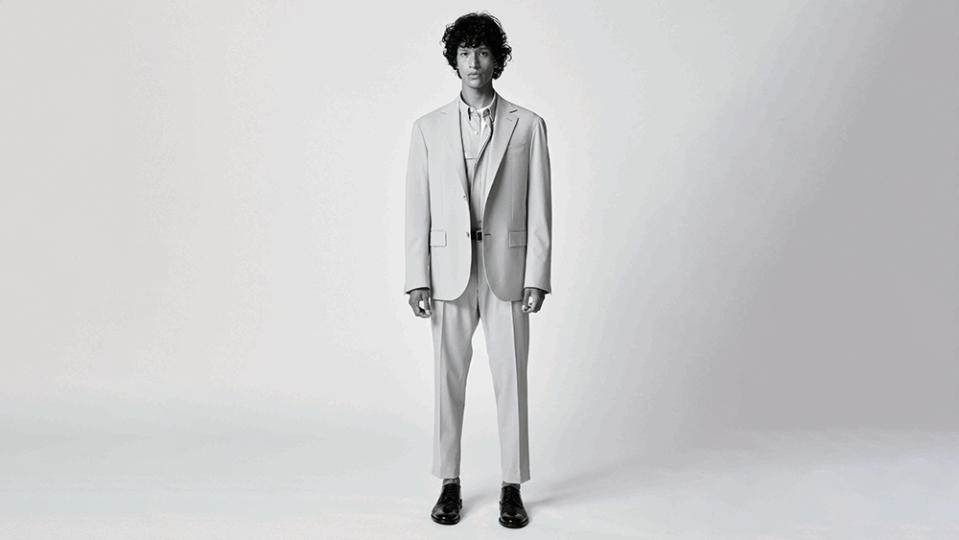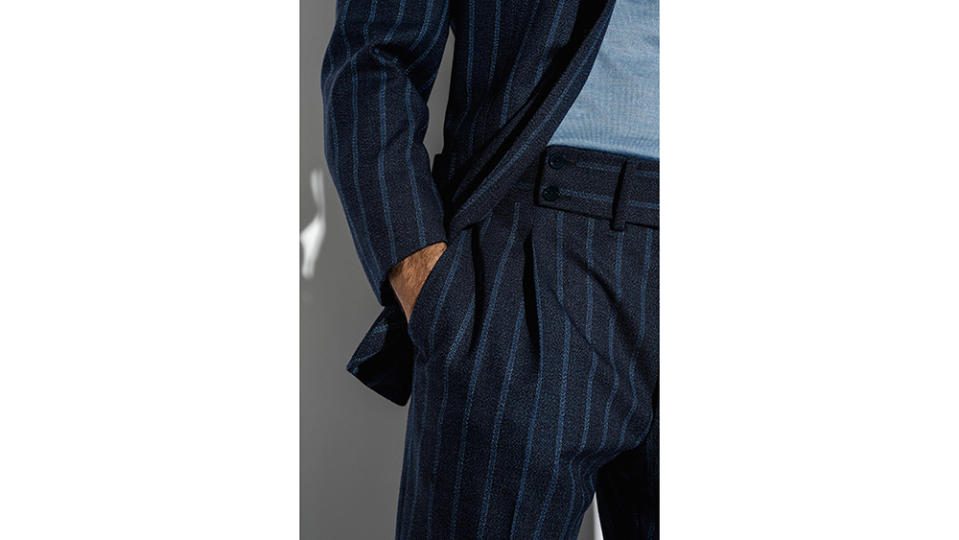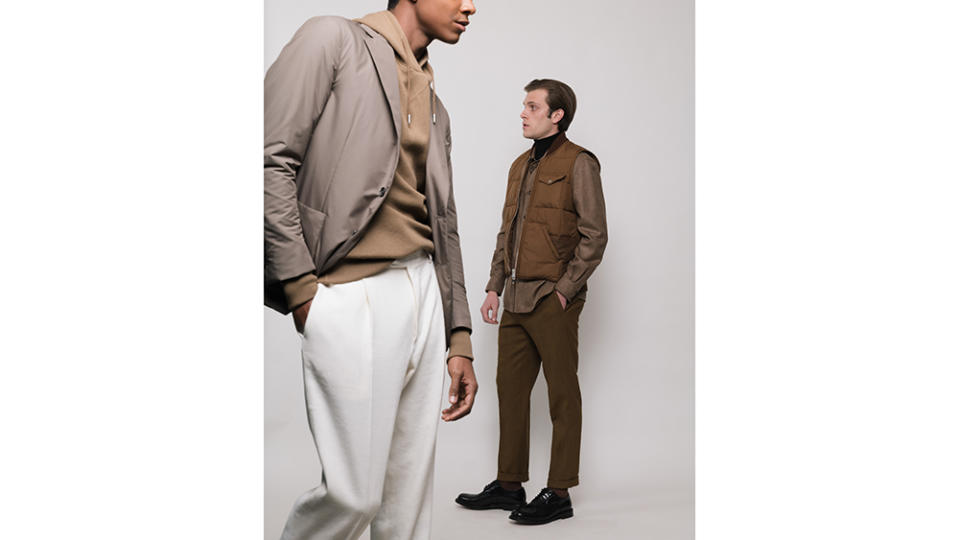How 3 of Italy’s Master Tailors Are Making Suits Lighter, Fresher and Easier to Wear

For the past five or six years—but especially during the last two—menswear writers around the globe have been either balefully lamenting or gleefully exclaiming, depending on their personal tastes, the demise of the suit.
And indeed, for a time, it looked like the suit might have been on the way out, with brands including Brooks Brothers in the US and Kilgour and Gieves & Hawkes in the UK declaring bankruptcy or entering liquidation in the wake of lockdowns and empty offices.
More from Robb Report
Inside the Philadelphia Menswear Shop Serving Old-School Haberdashery to a New Audience
Bespoke Tailor Paolo Martorano Is Offering Made-to-Measure Designs This Fall
Around the globe, yes, but in Italy, not so much. According to an admittedly unscientific survey of a few stylish Italian friends, far fewer column inches have been penned there on the subject. Italian tailoring has fared better than elsewhere, perhaps because it’s a different kind of animal: softer and less formal than its Parisian and English counterparts, more lightly constructed and relaxed in attitude than its American cousins. So the Italian sensibility is better primed to adapt more naturally to what is required right now. But possibly, too, because Italian men tend to wear tailored clothing differently—more casually, with an extra shirt button (or two) undone, with jackets unfastened, with loafers. Not just for work. For whenever they want to feel, and look, their best. You’ll often see older Italian men meeting up in town squares wearing tailoring that has clearly been worn for many years and still looks great.
So what can the stylish man, and indeed the style industry, learn from the Italians? We spoke to three of Italy’s biggest sartorial players—Corneliani, Isaia and Caruso—to find out. With close to a year of normal life behind them, this trio has found a post-pandemic-shutdown stride. All three make their clothing in their own dedicated tailoring factories and have evolved their offerings in interesting ways. What, then, do they believe menswear should look like in the post-business-suit era of 2022 and beyond?
To answer this question, Corneliani got creative. The label introduced a new, experimental sub-brand called Corneliani Circle for the fall/winter 2020 season, just before the pandemic struck. Designed with “a forward-looking approach,” the resulting capsule collection—which featured distinctive pieces such as organic-cotton field jackets and blazer-meets-chore-coat hybrids—marked a step change for a company that has historically relied on traditional suiting. At the start of this year, Corneliani Circle was granted its own dedicated design lead, Paul Surridge, a Briton who was formerly creative director of Roberto Cavalli. Billed as a collaboration with the new label, Surridge’s role is to “rejuvenate” Corneliani’s classicism and use the Circle collection to set a new, relevant direction. What does “rejuvenating” classic tailoring mean to him? Interviews have been lightly edited and condensed for clarity.
Paul, you started to collaborate with Corneliani on Corneliani Circle in January. What were you thinking after two years of pandemic disruption?
PS: For me, that period was almost a complete reduction of taste, a reduction of style. We were just left with comfort—that was all that mattered. Consumers were bombarded with images of A-list celebrities and style icons in slouchy home attire. The glitz and glamour of the red carpet disappeared. Also, I don’t think the [pandemic] killed [streetwear], but it was already saturated, oversaturated, because it was in everyone’s lives.

Courtesy of Corneliani
How has this filtered into your new vision for Corneliani Circle?
PS: I looked at Corneliani and felt that [the Circle capsule] was an opportunity to rejuvenate tailoring and attract a more fashion-forward demographic by using comfort to do something very elegant.
And what does good taste mean to you?
PS: This whole idea of “radical chic.”
I like “radical chic.” Are you talking about the term Tom Wolfe coined with reference to liberals dressing like radicals?
PS: Yes, I heard the term from a close friend and CEO of a luxury brand when we were discussing design and luxury today. The “radical” works for me because I wanted to be a bit more provocative with the idea of tailoring for Corneliani. For me, this project is about how far I can push the envelope, while being relevant to the brand. The “chic” component is in the colors we used, which are very familiar but put into a differ- ent context. Beautiful earthy tones and sophisticated shades—I find them quite peaceful.
Surridge’s first capsule collection, which will be available next spring, epitomizes this idea. The items are more generous and slouchier than Corneliani’s clean-cut mainline suiting, with a washed-out color palette and a focus on easy mix-and-match pieces. It’s a very different approach for the brand but still understated and composed. Take, for example, the collection’s Architect jacket, which references a straitlaced British look, with square proportions and a three-button front. Despite its classic roots, the jacket in Surridge’s hands is a subversive piece for customers “with a younger mindset,” distinctive in its silhouette and construction.
PS: It’s an oversized, upscaled blazer. We cut it in wool, hemp and silk, which I was worried might feel a bit [old-school], but by underpinning it with a white T-shirt, a tailored pant and then a long belt, it felt contemporary—like we’d tipped something very traditional into a modern key.
Do you think that modern tailoring still has a place in a man’s wardrobe today?
PS: Totally, it never goes away. The male wardrobe is defined by the shoulder. The shoulder expresses the times.
So, what are your shoulder lines saying about the future of men’s style?
PS: For tailoring to work it has to reflect the mood, so it has to be comfortable. It has to be loose; it can’t be fitted. It has to be soft. The shoulder has to be lightly constructed, and the jacket’s collar has to sit around the neck like a scarf. When you combine these things with the silhouette we worked on, with the jacket longer in the front and the shoulder seams thrown towards the back, you end up with a slightly sportier, easier feel. These aren’t clothes for a suited-and-booted investment banker in a boardroom.
Is the business suit on its way out, then?
PS: I think the idea of a uniform, of “institutional dressing,” is gone. The corporate suit will still exist because some professionals will always need to wear one, but in a world where most of us don’t need to wear suits, we have an opportunity to remove tailoring’s formal aspect and put it into an informal context, which I think is very fresh.
If Corneliani Circle’s new direction is all about quiet, contemporary elegance, at colorful Neapolitan brand Isaia, CEO Gianluca Isaia, representing the third generation of family ownership, has taken a different tack. Isaia has moved quickly to pivot its in-house production, supplementing flamboyant suiting with casual sportswear and all the pieces a man needs to dress down his suits and sport coats. In the first half of 2022, sportswear accounted for 40 percent of sales, twice what it was going into the pandemic. Dialing in from a break on Capri, Isaia talked about this new strategy and how he’s elevating sportswear with a tailored sensibility.
GI: In 2019, the company was growing in a healthy way—we’d had double-digit growth every year for the past four or five years. Then Covid hit and we had a huge shock, because our sales were mostly concentrated in jackets, suits, dress shirts and ties. Perhaps only 20 percent of our sales was sportswear.
That sounds challenging. How quickly were you able to respond to that, and what did you do?
GI: Even in the first lockdown, we started to plan a new strategy. Over the last two years we’ve internalized most of the production of casualwear categories that in 2019 we were making with external factories. Our own factory started to produce pajamas, robes, polo shirts and jersey pieces. If nothing else, we had to keep all our makers busy, because there was no need to make any of our tailoring.

Courtesy of Isaia
You clearly recognized the need to respond to the pandemic by creating casualwear. But how do you think the pandemic has changed men’s style long-term?
GI: Men won’t go back in terms of comfort. Take, for example, the classic pant. We are selling more drawstring pants to wear under blazers than we ever have before, even in classic tailoring fabrics. Men’s shoes are different, too—men want more comfortable shoes. Honestly, today, I don’t know if we’ll ever go back to wearing ties.
So luxury sportswear is a growth area for Isaia, then? Is that customer any different from your tailoring one?
GI: Our customer can tell if a buttonhole is sewn by hand or not, and he can recognize hand-stitching, whether it’s in a jacket or a jersey polo. Certainly, our jersey is selling extremely well. We buy the fabrics from the best Italian mills, in cashmere-silk or cotton-silk, and cashmere-cotton blends.
But tailoring is still a significant part of your sales, so how are your customers combining suiting and sportswear?
GI: Let’s say a mix between tailored pieces and sportswear [simultaneously] that feels very fluid. Certainly, that’s what we now stand for as a brand.
Back in the north of Italy, in the town of Soragna, Caruso’s 420-strong tailoring workshop is struggling to keep up with renewed demand. “Production-wise, many brands thought the jacket was dead, and they shut down their own production. Now they’re coming to us,” says CEO Marco Angeloni, who joined the company in 2019 and has steered the ship through the pandemic’s choppy waters. Angeloni’s take on menswear is subtler than that of Surridge and Isaia. Caruso’s collections aren’t as flamboyant as Isaia’s, nor as fashion-led as Corneliani Circle’s. Instead, Angeloni is seeing his customers embrace “playful elegance” and a revived interest in the classics, including statement eveningwear.
Let’s get the obvious question out of the way at the start. How has the pandemic changed menswear for you, and for Caruso?
MA: When it arrived, everyone’s motto was: “The jacket is over. You don’t need a jacket for a video conference.” I think that was true for four or five months.
Now I really believe there’s a desire for a man to, first of all, enjoy life more, and to find pleasure in dressing up again. For sure, this isn’t a comeback of the uniform.
The uniform is something that, in my opinion, was already dead before the pandemic. The pandemic hit it really hard. Now the jacket is coming back because it’s an object of desire. All of a sudden, it’s a way of being chic again. I think we’re seeing something more playful but still elegant coming back.
What does that mean to you? What makes a jacket an object of desire?
MA: It means that we are talking to a man who wants to dress in a way that shows that his clothes are his own choice, not his boss’s choice. Last season, sales were 68 percent up, which for us is a gigantic comeback. But if I look at the colors, before the pandemic it used to be 80 percent blue, perhaps 16 percent gray and then a touch of something else. Now it’s not all about blue. We’re seeing more natural colors sell, like camel, shades of green—something that shows you have taste.
Caruso’s fall/winter ’22 collection, inspired by perennial style muse Miles Davis, is awash in earthy colors and luxurious separates. And as Isaia mentioned, there’s not a tie in sight. Instead, sleek knitwear underpins tonal tailoring, and there’s a surprising focus on standout tuxedos, whether in bright brown silk-wool or bold silk-wool jacquard. Looking ahead to spring 2023, Caruso has developed several new qualities of seersucker in superfine tropical wool, in green, camel and other contemporary colors, challenging the fabric’s stuffy blue-and-white-striped stereotype. But, if Caruso’s styling and fabrications are evolving, the brand’s two oldest and most classic jacket models have quickly bounced back.

Courtesy of Caruso
MA: During the pandemic, we introduced a technical jacket called Ponza, entirely made from Japanese nylon. It sold very well back then. Now I see this is already decreasing because, all of a sudden, people are asking for suits.
So technical, “novelty” tailoring had its moment in the pandemic, but actually that moment has passed?
MA: Yes. Now the Aida jacket [Caruso’s signature tailored jacket] is our best-selling item, a classic jacket in which there’s no shoulder pad whatsoever, just the canvas that runs up into the shoulder. If you look at the category of suits and jackets, the Aida will be almost 50 percent of sales—it’s really strong.
At the same time, we’re seeing an item which we thought was dead, our Norma jacket, which is more constructed, is coming back. I’m not sure whether it’s a fashion statement, or a reaction to hoodies and sweatshirts with no shoulder to them, but there’s a trend coming back there.
So, in 2022, the traditional business suit is on the rocks, and expressive “lifestyle” tailoring to socialize in is on the upswing. But if comfort was menswear’s buzzword in 2021, today the concept is combining with newfound sartorial freedoms and the desire, as Angeloni emphasizes, to play with the traditional uniform and still be elegant.
While the pandemic dealt many suiting brands a heavy blow, it has also helped some tailoring houses—Isaia, Caruso and Corneliani among them—break new ground and rethink what matters to their clients. Gianluca Isaia’s own personal definition of elegance speaks to this shift in perspective:
GI: I don’t think the concept of elegance has changed from before Covid. Elegance is something really personal. I always give this example: You have to imagine yourself on a stage alone with a lot of people in front of you. If you feel comfortable with what you’re wearing, you can be elegant anywhere.
What makes a man elegant in 2022, then?
GI: What has changed is the old concept of the rules: “The shirt has to be like this, the length of the jacket has to be like that.” Now we help our customers to find their own rules to be comfortable, and so to be elegant.”
Best of Robb Report
Sign up for Robb Report's Newsletter. For the latest news, follow us on Facebook, Twitter, and Instagram.

